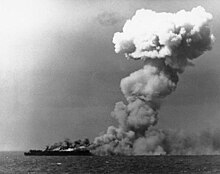Battle of Cape Engaño
| Battle of Leyte Gulf | |||||||
|---|---|---|---|---|---|---|---|
| Part of the Pacific Theater of World War II | |||||||
 The light aircraft carrier Princeton on fire, east of Luzon, on 24 October 1944. |
|||||||
|
|||||||
| Belligerents | |||||||
|
|
|
||||||
| Commanders and leaders | |||||||
|
(3rd Fleet) (7th Fleet) (Taffy 3 / Task Unit 77.4.3) (Task Group 77.2) (Task Force 74) |
(Center Force) (Southern Force) (Southern Force) (Northern Force) (Kamikazes) |
||||||
| Strength | |||||||
|
~300 ships in total 8 fleet carriers 8 light carriers 18 escort carriers 12 battleships 24 cruisers 166 destroyers and destroyer escorts Many PT boats, submarines, and fleet auxiliaries About 1,500 planes |
67+ ships in total 1 fleet carrier 3 light carriers 9 battleships 14 heavy cruisers 6 light cruisers 35+ destroyers 300+ planes (including land-based aircraft) |
||||||
| Casualties and losses | |||||||
| ~3,000 casualties; 1 light carrier, 2 escort carriers, 2 destroyers, 1 destroyer escort sunk 200+ planes |
~12,500 dead; 1 fleet carrier, 3 light carriers 3 battleships, 10 cruisers, 11 destroyers sunk ~300 planes |
||||||
Decisive Allied victory
The Battle of Leyte Gulf is generally considered to be the largest naval battle of World War II and, by some criteria, possibly the largest naval battle in history.
It was fought in waters near the Philippine islands of Leyte, Samar and Luzon, from 23–26 October 1944, between combined American and Australian forces and the Imperial Japanese Navy. On 20 October, United States troops invaded the island of Leyte as part of a strategy aimed at isolating Japan from the countries it had occupied in Southeast Asia, and in particular depriving Japanese forces and industry of vital oil supplies. The Imperial Japanese Navy (IJN) mobilized nearly all of its remaining major naval vessels in an attempt to defeat the Allied invasion but was repulsed by the U.S. Navy's 3rd and 7th Fleets. The IJN failed to achieve its objective, suffered very heavy losses, and never sailed to battle in comparable force thereafter. The majority of its surviving heavy ships, deprived of fuel, remained in their bases for the rest of the Pacific War and suffered under heavy sustained aerial attack.
The battle consisted of four separate engagements between the opposing forces: the Battle of the Sibuyan Sea, the Battle of Surigao Strait, the Battle of Cape Engaño and the Battle off Samar, as well as other actions.
...
Wikipedia
